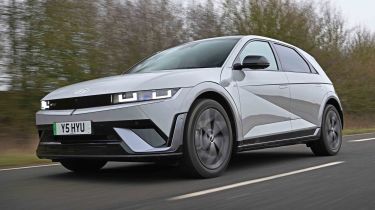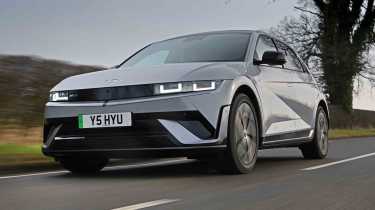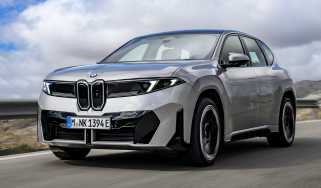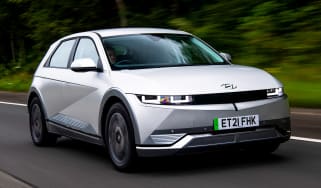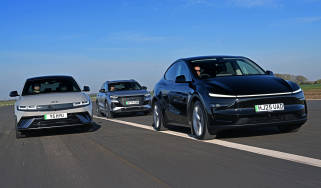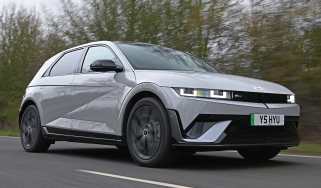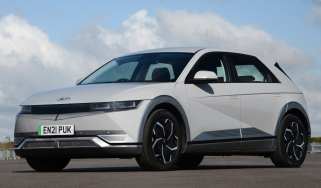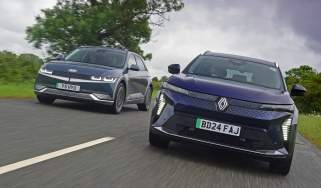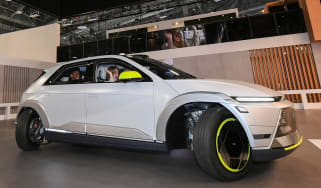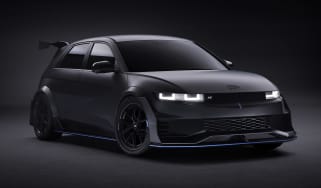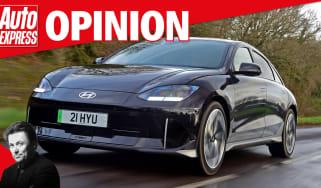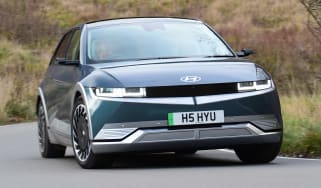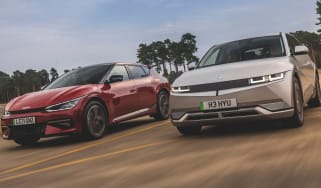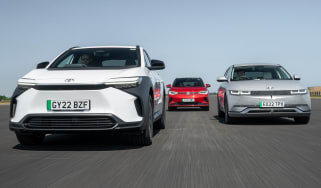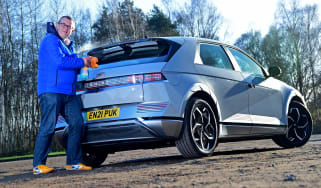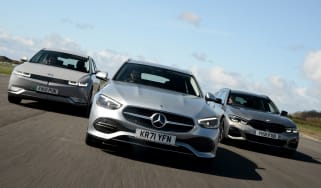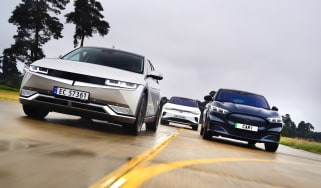Hyundai Ioniq 5 review
Striking Hyundai Ioniq 5 EV has received a mid-life makeover and remains as competitive as ever

Our opinion on the Hyundai Ioniq 5
We made the Hyundai Ioniq 5 our Car of the Year in 2021, and today it’s still an appealing electric family car. A range of minor updates for the 2025 model year have boosted its refinement, tech and range, but none of the revisions come at the detriment of the overall package. While it looks like a sharply-styled hatchback, the Ioniq 5’s size means there’s excellent cabin space, and the design of the interior only helps to emphasise this. Add in a relaxing and smooth drive combined with decent performance, and it should be on any electric family car shortlist.
| Key specs | |
| Fuel type | Electric |
| Body style | Five-door, five-seat crossover |
| Powertrain | 1x e-motor, 63kWh battery, rear-wheel drive 1x e-motor, 84kWh battery, rear wheel drive 1x e-motor, 84kWh battery, four wheel drive |
| Safety | Five-star Euro NCAP (2021) |
| Warranty | Five years/unlimited miles |
About the Hyundai Ioniq 5
The Hyundai Ioniq 5 was a landmark model for the Korean car maker. While the brand had made very capable cars before – in some cases good enough to challenge the very best in their respective segments – it wasn’t until this angular, retro-futuristic hatchback burst onto the scene that Hyundai offered family-car drivers an electric model that was truly desirable.
When it arrived in 2021, nothing looked remotely like it, and that’s still the case today. Even among its mechanically similar siblings, the Kia EV6, Genesis GV60 and Hyundai’s own Ioniq 6, which look unique in their own right, it’s the Hyundai that turns the most heads.
Used - available now

2022 Hyundai
Ioniq 5
35,305 milesAutomaticElectric
Cash £21,169
2022 Hyundai
Ioniq 5
13,633 milesAutomaticElectric
Cash £21,819
2023 Hyundai
Ioniq 5
11,449 milesAutomaticElectric
Cash £18,037
2022 Hyundai
Ioniq 5
29,660 milesAutomaticElectric
Cash £20,014The design isn’t just striking, but cleverly executed, too. In pictures, its proportions suggest it’s the size of a family hatch such as a Volkswagen Golf, but in reality it’s larger. At 4.6 metres, it’s even longer than the brand’s Tucson SUV, although it’s a little lower.
A range of updates were incorporated as part of a mid-life refresh in 2025, the most obvious being the introduction of N Line and N Line S trims. An angular bodykit inspired by the hot Ioniq 5 N flagship adds a sporty aesthetic to the main range. All cars also gain a beefed-up rear axle, revised shock absorbers and a rear windscreen wiper, a glaring omission when the original car was launched.
Another key update for buyers who drive long distances is an updated battery pack, which increases capacity from 77.4kWh to 84kWh. Along with tweaked aerodynamics, this has boosted the car’s range.
Prices for the Ioniq 5 start from just under £40,000, and the line-up comprises of Advance, Premium, N Line, Ultimate, and N Line S. The hot Hyundai Ioniq 5 N performance model is marketed as a separate machine, and you can read about it in our dedicated review.
There’s the sole five-door, five-seat hatchback-style body offered – if you want something different, then the slippery Ioniq 6 looks distinctive. There are three powertrains to choose from, with Advance and Premium available with rear-wheel drive and either a 63kWh or 84kWh battery, while the jump in price to N Line cars and above is because they are offered exclusively with the larger battery, plus a choice of rear or four-wheel drive.
If you're interested in getting yourself a Hyundai Ioniq 5, we can help. Configure your ideal Hyundai Ioniq 5 now to get top offers from local dealers, check out the latest Hyundai Ioniq 5 leasing deals, or search for used Hyundai Ioniq 5 models with our Find A Car service. You can even sell your existing car for a great price with Auto Express Sell My Car.
Performance & driving experience
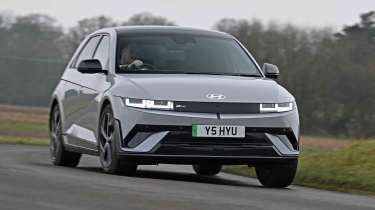
| Pros |
|
| Cons |
|
Hyundai has pitched the Ioniq 5 towards the more comfortable end of the segment, and while there are one or two areas that we think could be improved, it’s a set-up that makes more sense than some of its firmer – but ultimately no better to drive – rivals.
Ioniq 5 buyers have the choice of one motor or two. There’s a pair of single-motor options that have either 168bhp or 225bhp, with both producing maximum torque of 350Nm. That less potent model has a smaller battery, which has a 63kWh usable capacity compared with the 225bhp model’s 84kWh. The larger pack was introduced as part of the mid-life update, and increased the capacity from the previous 77.4kWh figure. Above these is the AWD option. A second motor up front boosts the power and torque to 321bhp and 605Nm respectively. This four-wheel-drive model is available exclusively with the 84kWh battery.
Extra sound deadening was applied to the rear motor area during the Ioniq 5’s mid-life update. While we didn’t find the previous version intrusively noisy, very little sound now reaches the cabin – only the gentle hum of the pedestrian-warning system at low speeds breaks the silence.
Brake regeneration strength is controlled by paddles behind the steering wheel, with the power ranging from complete freewheeling to one-pedal driving. The paddle system is still the best and most intuitive system we’ve used for adjusting brake regen on the move.
Electric motors, 0-60mph acceleration and top speed
The 168bhp model can sprint from 0-62mph in 8.5 seconds, which will be fast enough for most people, while the extra 57bhp gives the more powerful (and heavier, thanks to the larger battery) option a 0-62mph time of 7.5 seconds. Four-wheel drive helps the 321bhp version to accelerate from 0-62mph in 5.3 seconds. All versions of the Ioniq 5 have a top speed limited to 114mph.
Town driving, visibility and parking
Softened dampers have improved the latest Ioniq 5’s ride comfort over the pre-facelift model’s, but we found that when we compared the Hyundai with the updated Tesla Model Y and Audi Q4 e-tron, the Hyundai delivered a slight brittle feeling in the way it deals with harsher bumps. This was most obvious by a shimmy through the steering column that wasn’t present in the other two cars, despite the fact that this was an area that Hyundai focused on improving from the original car.
That aside, the steering’s precision, weight and response feel more natural than in many rivals, especially the Tesla Model Y’s. The wheel is usefully light around town, but the 12-metre turning circle is large, especially when compared with a Skoda Enyaq’s 9.3 metres (or 10.8 metres for 4WD models).
B-road driving and handling
At higher speeds, the Ioniq 5’s soft suspension makes the car wallow through the corners. Although it’s not particularly fun to drive, that sense of body roll does give the driver feedback as to how much cornering force the chassis is able to handle. With its fairly relaxed settings, there’s less incentive to drive hard through bends, so it encourages a more relaxed driving style. This is emphasised by the car’s width, which also remains in the back of your mind when cruising along a rural road with blind corners.
The car’s closest mechanical relative, the Kia EV6, doesn’t feel sharp enough through corners to justify its firm suspension set-up, yet the Ioniq 5 is unapologetically soft in comparison.
Single-motor versions of the Ioniq 5 gently push the chassis from the back axle, thanks to their real-wheel-drive layout, while four-wheel-drive models have strong traction, as you’d expect. Either way, the experience isn’t fun as such, but it’s well judged for what is primarily a sensible family car.
Big EVs such as the Ioniq 5 are fairly hefty, with weights ranging from 1,880kg in its base small-battery form up to 2,190kg in all-wheel-drive guise. It’s under braking where the model’s mass is most noticeable, with emergency stops revealing that it’s not quite as responsive as a smaller, lighter car. Motor regeneration helps with smaller deceleration manoeuvres, and the steering wheel-mounted paddles to adjust through a series of regen strengths are excellent. It’s among the best systems we’ve used in an EV.
Motorway driving and long-distance comfort
That retro-futuristic shape looks striking, but with a drag coefficient of 0.288Cd (depending on trim), the Ioniq 5 isn’t quite as slippery though the air as some of its rivals. This has the largest effect at motorway speeds, where the Hyundai not only produces a touch more wind noise than some rivals, but it also takes a bigger efficiency hit due to not passing through the air as cleanly. It’s a little more refined than rivals from the Volkswagen Group, though.
Stability and high-speed comfort are excellent, and the steering is relaxed enough that the car doesn’t feel nervous, while the cabin is a fairly relaxing place in which to tick off the miles.
“Of all the detailed design tweaks that Hyundai has introduced for 2025, one of the simplest is also one of the most welcome. That’s because it has finally seen sense and fitted a rear window wash/wipe system to the Ioniq 5. While Hyundai isn’t the only firm guilty of not fitting one previously, it was silly to assume that the car’s aerodynamics would keep it clean.” - Alex Ingram, chief reviewer
| Model | Power | 0-60mph | Top speed |
| Standard Range | 168bhp | 8.5s | 114mph |
| Long Range | 225bhp | 7.5s | 114mph |
| Long Range AWD | 321bhp | 5.3s | 114mph |
Range, charging & running costs
| Pros |
|
| Cons |
|
Efficiency figures are not outstanding for the class, although a standard-fit heat pump across the range should mean consistent efficiency when the weather turns cold. There are rivals that both use less energy and hold their value better, but the Ioniq 5 is still cheaper to run as a company car than a similarly sized petrol or diesel model if you can make the most of cheap home charging.
Electric range, battery life and charge time
On paper, the Ioniq 5 has some very compelling range figures. The increased battery capacities and superior aerodynamics bring a range of improvements, and where the previous car could achieve, at best, a WLTP range of 315 miles, the revised model ups that to 354 miles. That figure is for single-motor models, but even the most potent twin-motor cars can almost match the best that the outgoing single-motor variant could achieve, hitting 307 miles on the WLTP cycle. The entry-level version with the smaller 63kWh battery can cover 273 miles – 35 miles up on the model it replaces.
As before, the Ioniq 5 doesn’t appear to be at the top of the class for efficiency, but we’ll reserve our full judgement until we’ve tried the car in much warmer weather. While warmer temperatures have improved things slightly – seeing the figures rise from 2.6 miles/kWh on our first encounter to 3.1 miles/kWh when tested in the spring – enough to increase the real-world range from 218 miles to 260 miles – it’s still not on a par with the Tesla Model Y.
It’s another reason why we’d take the more efficient rear-wheel-drive, single-motor car over the all-wheel-drive model. Not only will it save you some cash over the total cost of ownership, but it costs less to buy up front, too. The extra 15 or so per cent of real-world range will also make all the difference for those who frequently cover longer distances.
Officially, the Ioniq 5 will charge at up to 233kW, making it possible to top up the battery from 10-80 per cent in 18 minutes. But due to the nature of its 800-volt system, you’ll need a 350kW charger to achieve that; without it, the speeds aren’t so impressive.
| Model | Battery size | Range | Insurance group |
| Standard Range | 63kWh | 273 miles | 33 |
| Long Range | 84kWh | 354 miles | 38 |
| Long Range AWD | 84kWh | 320 miles | 41 |
Insurance groups
With each car’s group depending on its power and trim level, the Ioniq 5 starts in group 33 insurance and climbs to group 41, while the hot Ioniq 5 N is in group 49 out of 50. This is broadly similar to most EV rivals in the same segment.
Tax
Every version of the Ioniq 5 sits in the lowest Benefit-in-Kind (BiK) tax band for company cars, which, as of April 2025, stands at three per cent. That makes the Hyundai as cheap to run as any other EV, and much less costly than a similarly priced plug-in hybrid, hybrid, petrol or diesel car.
For private buyers, the tax incentives that EVs once enjoyed have largely disappeared. While first-year VED rates are set at £10, from then on they rise to £195 for the next five years. All but the base Ioniq 5 costs more than £40,000, so they’re subjected to an additional £425 a year from year two until year six.
Depreciation
Residual values aren’t great for the Ioniq 5 when compared with some rivals. The heaviest-depreciating model, the N Line S AWD, will maintain just 40 per cent of its original value after three years. The entry-level car is cheapest to buy, and its 44 per cent depreciation figure is much closer to the class average. At the top of the range, the flagship Ioniq 5 N has established itself as a desirable performance EV, so it has strong residual values of 56 per cent. In comparison, the mechanically Kia EV6 holds around half of its original value.
To get an accurate valuation on a specific model check out our free car valuation tool...
Interior, design & technology
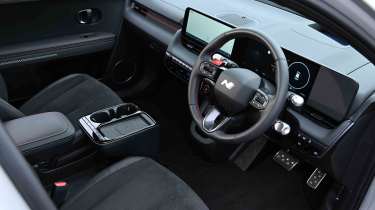
| Pros |
|
| Cons |
|
Concept car looks mean that the Ioniq 5 is a real head-turner that still stands out next to newer arrivals in the class. The retro-modern styling will appeal to those who appreciate a minimalist approach, although the LED headlight design adds some modern tech, with 256 individual ‘pixels’ used. This design has influenced other all-electric Hyundai Ioniq models, as well as the Hyundai Kona and Hyundai Santa Fe.
Inside, the driver is faced with a pair of 12.3-inch digital screens. One is a colour touchscreen covering the infotainment and sat-nav systems, while the other displays information for the driver. Minor interior updates for the 2025 model year don’t change the fact that there’s still much to like about the Ioniq 5’s cabin.
Interior and dashboard design
For 2025, the cabin maintains the same light, airy ambience that has always made the Ioniq 5 feel so spacious, but there are a few detail changes worthy of note. While some brands have increasingly veered towards touchscreen controls – or while some newer marques have turned their back on physical switches from the outset – Hyundai is strongly backing real buttons in its cabins, to the point where the revised Ioniq 5 actually features more than its predecessor.
The overall layout is largely the same as before, but the raised centre console between the front seats has been given the most extensive update, introducing more shortcut keys and a repositioned wireless smartphone charger that places it closer to the user’s hand.
The steering wheel gets a subtle update, with ‘pixel’ lights glowing at its centre – there’s still no Hyundai logo there – while the shortcut buttons above the climate controls have been subtly tweaked. Hyundai says this is to “enhance operational convenience”, but they were reasonable before and the change isn’t night and day now.
Materials and build quality
While the interior design looks fairly distinctive, the quality isn’t quite up with the class best. A Peugeot E-3008, Skoda Enyaq or even the cheaper Renault Scenic feel a little more special inside and slightly more sturdy in terms of switchgear and plastics.
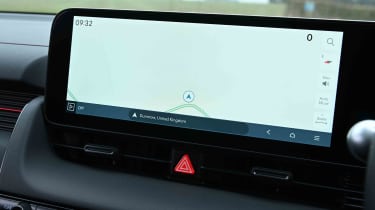
Infotainment, sat-nav and stereo
There are five trim levels to choose from, with even the base Advance spec featuring LED headlights, two 12.3-inch displays, adaptive cruise control with lane centring, a heated steering wheel and a heat pump to reduce the load of the cabin heater on cold days, as standard.
All but the base model get a 230-volt three-pin plug socket at the base of the back seats, too, enabling more power-heavy accessories to run off the car’s main battery. Digital side mirrors are available on top-spec trims, but we’d stick with the regular items for the sake of the tiny potential improvement in range the more aerodynamic cameras can offer.
The 12.3-inch touchscreen sits high up on the dash next to a driver’s display that is the same size, and its clear layout and no-nonsense graphics are fairly easy to use. But some menus are fiddly; the driver-assist page is opened via several button presses (plus a long press) on the steering wheel, and then the layout is a little fussy. Other brands, in particular Skoda and Renault, make switching the speed-limit warnings and lane-keep systems on and off much more intuitive.
“In addition to the technical upgrades applied to the Ioniq 5, Hyundai has also added a new trim level. N Line takes inspiration from the range’s halo model, the fabulous Ioniq 5 N, with a bodykit that adds extra menace to the exterior, and a new steering wheel design and black interior scheme that makes the cabin feel more sporty.” - Alex Ingram, chief reviewer
Boot space & practicality
| Pros |
|
| Cons |
|
One of the Ioniq 5’s big selling points is that it lets buyers benefit from SUV-like interior space without buying a car that looks like an SUV. But while the car is spacious for passengers and the boot volume is decent, the shape of the cargo area isn’t as useful as some rivals. That’s down in part to the five-door hatchback exterior styling, where the steeply angled tailgate limits what can be stored there.
Dimensions and size
While the Ioniq 5 looks like a hatchback, if you’ve seen one in real life, you’ll know that it’s far larger than a Volkswagen Golf or suchlike. At 4.6 metres long, it matches a Toyota RAV4, while the three-metre wheelbase ensures there’s lots of space in the cabin.
| Dimensions | |
| Length | 4,655mm |
| Width | 1,890mm |
| Height | 1,605mm |
| Number of seats | Five |
| Boot space | 420-1,580 (plus 24 litres under the bonnet) litres |
Driving position, seats & space in the front
The wide dash appears to float ahead of the driver and front passenger, with only a small console on the floor for extra storage. This opens up a flat area between the front occupants that makes it feel open and spacious. The driving position is fairly car-like, but higher than in a normal hatchback, but not quite as lofty as in an SUV: you sit quite high relative to the window line, granting the driver decent all-round vision, except for a slightly small rear window.
Side-view cameras, which engage when the indicators are activated, improve visibility when turning into tight junctions or when changing lanes on a motorway – the camera feed appears in the driver’s display.
Big door bins and the drawer-like glovebox offer useful storage options, while two deep cup-holders sit on the redesigned centre console, while the base of the dash has an extra cubby further forwards.
Seats & space in the back
There’s a huge amount of space in which to stretch out in the back, with only the Tesla Model Y, Kia EV6 and BYD Sealion 7 offering more kneeroom. However, the floor is a little high relative to the base of the seat, which means that some longer-legged occupants might find the level of under-thigh support not quite up to scratch. Headroom is decent, though, with a near-identical amount to the Hyundai Tucson SUV.
Apart from the base Advance model, all versions feature manual rear window blinds – a great feature for keeping the heat out and adding a little extra comfort for passengers.

Boot space
At 520 litres, the Ioniq 5’s boot appears very large, but while the load bay floor covers a sizable area, it’s fairly shallow, so it can’t carry bulky loads as well as some rivals. The seat backs drop completely flat when folded – a process which, post-facelift, is done electrically in Ultimate and N Line S models. Either way, the volume grows to 1,580 litres, which is less than in rivals such as the Skoda Enyaq and BYD Sealion 7.
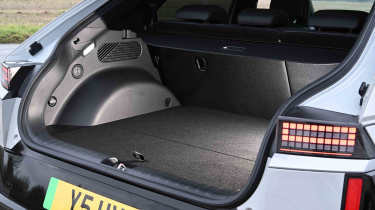
“There’s storage under the Ioniq 5’s bonnet, but it’s not very big. A total of 24 litres in the AWD model is barely enough for a charging cable, and even the 57 litres available in the RWD version is dwarfed by the likes of the Tesla Model Y (117 litres). Even the BYD Sealion 7 is slightly ahead, at 58 litres.” - Alex Ingram, chief reviewer
Reliability & safety
| Pros |
|
| Cons |
|
The Ioniq 5 has gained more safety tech for 2025, including hands-on detection for the steering wheel, improved lane-keep assist and remote smart parking assist functions, plus a collision-avoidance system that works from all angles, including when reverse parking. But the constant bongs for various warnings make it hard to keep up with which beep is the current issue. We’d like a little less nagging, but switching some of these systems off can be fiddly because of that infotainment set-up.
The model was awarded five stars by Euro NCAP in 2021, and these new features, plus a car which is now structurally stronger around the B-pillars to improve side impact protection, should see it remain up-to-date with the latest safety standards.
Hyundai was ranked 17th out of 32 brands in our 2024 Driver Power customer satisfaction survey. That’s an odd result considering that fellow Hyundai Group firm Kia finished third with cars using largely the same mechanicals.
| Key standard safety features |
|
| Euro NCAP safety ratings |
|
Buying and owning
Our best buy: Hyundai Ioniq 5 84kWh Premium RWD
If you don’t need the extended range of the 84kWh battery, then the 63kWh pack is fine, but you’ll need to charge it up more frequently. Premium trim has plenty of kit as standard, while Ultimate spec offers all the luxuries you can think of. We like these cars because the light cabin colours boost the cabin’s sense of space – the N Line variants are a little darker, so don’t feel quite as roomy (although there’s no difference to the space on offer), but some buyers will be tempted by the sportier looks that are offered by these models.
Hyundai offers a five-year, unlimited-mileage warranty for all of its passenger cars, along with 12 months of roadside assistance and free annual health checks of your vehicle for up to five years. The Ioniq 5’s lithium-ion battery is covered for eight years/125,000 miles, although it’s linked to a ‘minimum capacity’ caveat, which means any required repairs will return the battery to at least 70 per cent of its original capacity.
Hyundai offers service plans that are designed to meet your individual requirements, based on the car you own, expected mileage and the period you’d like the plan to cover. You can pay in a lump sum or interest-free monthly instalments.
Hyundai Ioniq 5 alternatives
If you’re not a fan of the Ioniq 5’s looks, then there are other models that share the same running gear. Closest is the Ioniq 6, which features dramatic, swooping coupé-style bodywork, while sister firm Kia offers the EV6 and another stablemate, the Genesis GV60. The Ioniq 5 is the most comfortable of these models, with the EV6 offering a slightly sportier feel and the Genesis ramping up the luxury inside.
Rivals from other manufacturers include the Tesla Model Y, which has been updated, while the Renault Scenic is a strong contender in the class that offers good value. The Ford Explorer and Ford Capri share Volkswagen-sourced running gear and offer a decent drive, while VW’s own Volkswagen ID.4 and Volkswagen ID.5 are also worth considering. Elsewhere, the BYD Sealion 7 is a recent arrival that matches the Ioniq 5 on price and kit, but isn’t as good to drive.
Hyundai Ioniq 5 pictures
Frequently Asked Questions
It’s one of our favourite electric family cars. There’s lots of space inside, it’s comfortable and has a unique style. That’s why we named it our 2021 Car of the Year at our annual New Car Awards.

